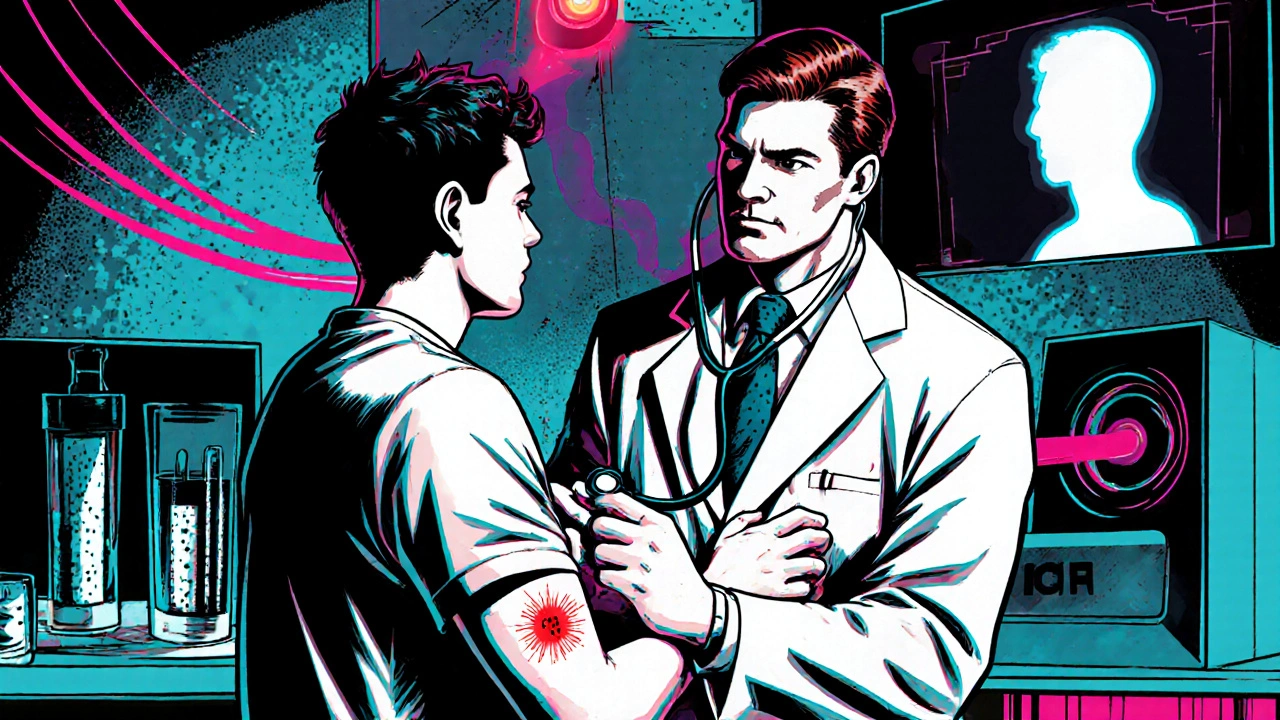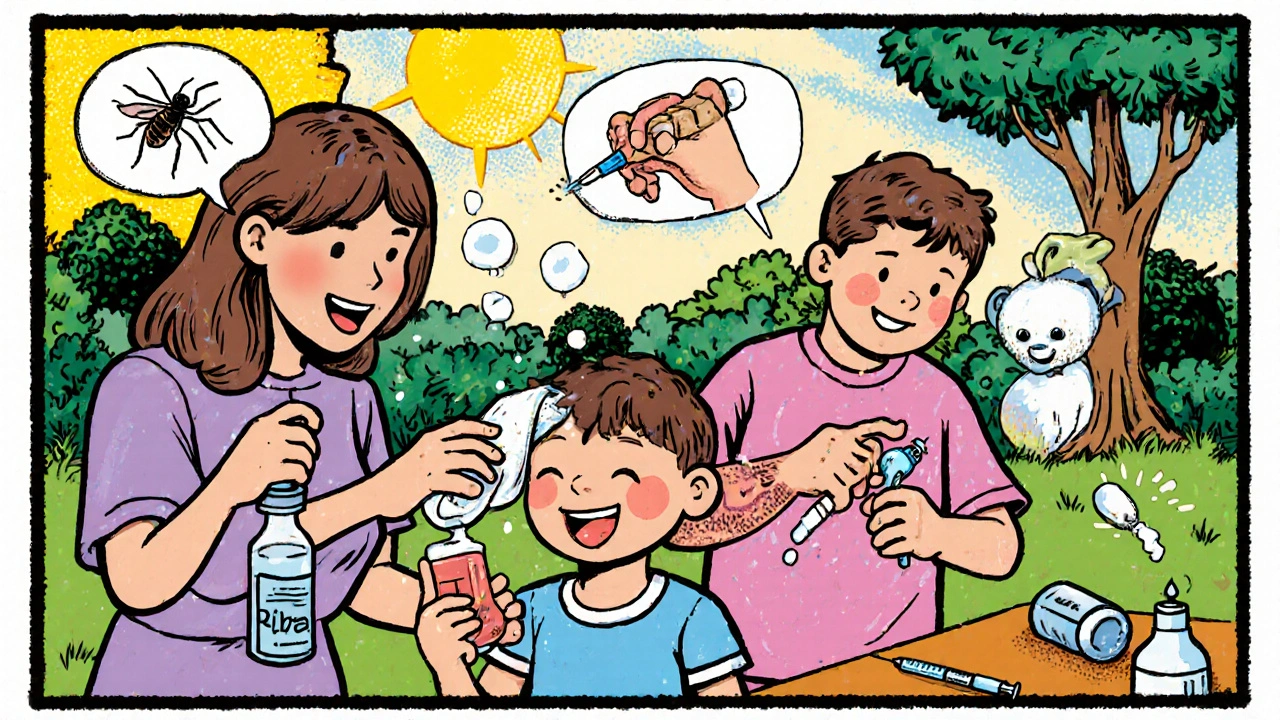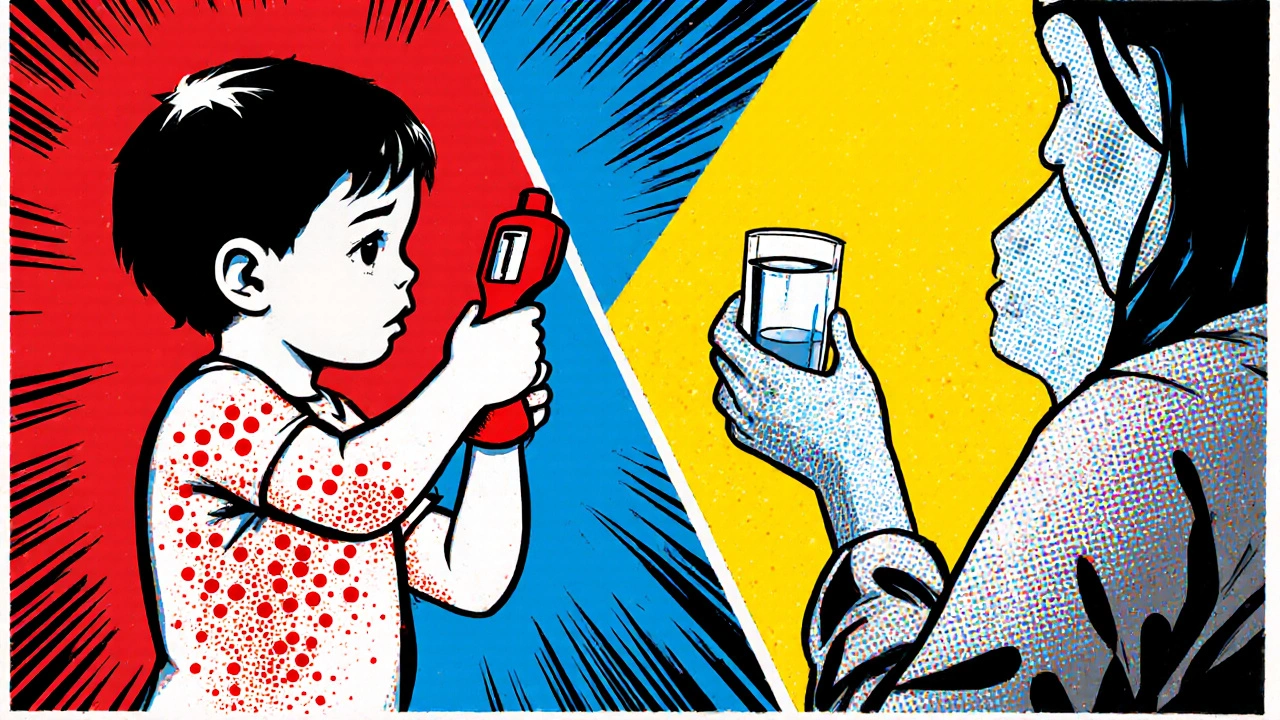Key Takeaways
- Fever with a rash can signal anything from a harmless viral infection to a serious medical emergency.
- Typical red flag signs include rapid fever rise, spreading rash, breathing trouble, or stiff neck.
- Home care-hydration, cool compresses, and over‑the‑counter antipyretics-helps most mild cases.
- Seek medical evaluation promptly if the rash is petechial, purpuric, or accompanied by severe symptoms.
- Knowing common culprits like Measles, scarlet fever, and drug allergies speeds up diagnosis.
Understanding the Link Between Fever and Skin Rash
Fever with skin rash is a clinical pattern where a rise in body temperature coincides with a visible change on the skin. The skin is the body’s first line of defense, so when an infection or immune reaction flares, blood vessels expand and inflammatory cells gather, creating a rash. The fever signals the internal battle, while the rash offers clues about the attacker.
Because many illnesses share these two signs, doctors treat the combination as a diagnostic puzzle. The goal is to match the rash’s shape, color, and distribution with the fever’s pattern and the patient’s age, recent exposures, and medical history.
Common Causes of Fever and Rash
Below is a quick snapshot of the most frequently encountered culprits. Each condition has a distinct rash signature and fever trajectory.
| Cause | Typical Rash | Fever Pattern | Age Group Most Affected | Urgency |
|---|---|---|---|---|
| Measles | Red maculopapular spots, start at hairline, spread downward | High (101‑104°F), lasts 3‑5 days | Children 5‑15y | Moderate - watch for pneumonia |
| Scarlet fever | Fine sandpaper‑like rash, spares palms/soles, strawberry tongue | Sudden spike, 102‑104°F | Kids 2‑10y | High - treat with antibiotics |
| Kawasaki disease | Strawberry tongue, cracked lips, swelling of hands/feet | Persistent >102°F for >5days | Infants & toddlers | Critical - risk of coronary aneurysm |
| Drug allergy | Hives or widespread urticaria, sometimes blistering | Can be low‑grade or high‑grade | Any age | Variable - seek care for swelling of face/airway |
| COVID‑19 | Variable - maculopapular, vesicular, or “COVID toe” | Low‑grade to high, may spike | All ages | Moderate - monitor for breathing problems |
| Meningitis | Petichial or purpuric spots, especially on trunk | Rapid rise, often >103°F | Infants & adolescents | Emergency - immediate treatment needed |
| Rocky Mountain spotted fever | Small red spots that become petechial | Fever 101‑104°F, may fluctuate | People in tick‑endemic areas | Urgent - start doxycycline early |

Red‑Flag Symptoms: When to Call the Doctor
Not every fever‑rash combo is an emergency, but certain signs warrant immediate medical attention:
- Fever >104°F (40°C) that doesn’t drop with acetaminophen or ibuprofen.
- Rash that does not blanch (turn white) when pressed, especially petechiae or purpura.
- Difficulty breathing, wheezing, or a hoarse voice.
- Severe headache, neck stiffness, or photophobia (light sensitivity).
- Swelling of the lips, eyes, or tongue-possible anaphylaxis.
- Sudden change in mental status, lethargy, or seizures.
These clues suggest a systemic infection, allergic reaction, or vascular involvement that needs labs, imaging, or IV therapy.
Immediate Relief Strategies You Can Try at Home
For mild cases, simple measures often bring comfort while the body fights the underlying cause.
- Hydration: Offer water, oral rehydration solutions, or clear broth every hour. Fever increases fluid loss through sweat.
- Cool compresses: Apply a damp washcloth to the forehead, neck, or wrists for 10‑15minutes. Avoid ice packs directly on skin.
- Fever reducers: Give acetaminophen (10‑15mg/kg) or ibuprofen (5‑10mg/kg) according to age. Never mix with alcohol.
- Anti‑itch relief: Calamine lotion or a colloidal oatmeal bath eases mild hives and itching.
- Clothing: Dress in lightweight, breathable fabrics. Over‑bundling can trap heat.
If the rash is itchy, keep nails trimmed to prevent skin breaks that could lead to secondary infection.

Medical Evaluation: What Doctors Look For
When you visit a clinic, the clinician will combine history, physical exam, and targeted tests.
- History: Recent travel, sick contacts, new medications, vaccinations, tick bites, or exposure to allergens.
- Physical exam: Distribution, shape, and feel of the rash; temperature curve; looking for lymph node enlargement.
- Lab work: Complete blood count (CBC) to spot leukocytosis or low platelets, C‑reactive protein (CRP) for inflammation, and specific serologies (e.g., measles IgM, streptococcal ASO).
- Skin scraping or biopsy: Helpful for vesicular or atypical rashes when the cause is unclear.
- Imaging: Chest X‑ray if pneumonia is suspected, or lumbar puncture for meningitis signs.
Results guide treatment-antibiotics for bacterial infections, antivirals for certain viral illnesses, or steroids for severe allergic reactions.
Prevention Tips to Reduce Future Episodes
Many fever‑rash triggers are avoidable with a few everyday habits:
- Stay up‑to‑date on vaccinations-MMR (measles, mumps, rubella) cuts the risk of measles by >95%.
- Practice good hand hygiene, especially before meals and after using the restroom.
- Use insect repellent and check for ticks after outdoor activities in endemic regions.
- Read medication labels; ask pharmacists about possible skin‑related side effects.
- Maintain a balanced diet rich in vitamins A, C, and zinc to support immune health.
While you can’t guarantee you’ll never get a fever‑rash combo, these steps lower the odds and help you catch problems early.
Frequently Asked Questions
Can a simple viral cold cause a rash?
Yes. Some common colds, especially those caused by adenovirus or parainfluenza, can produce a mild maculopapular rash that fades as the fever subsides.
When should I use ibuprofen instead of acetaminophen?
Ibuprofen also reduces inflammation, making it useful if the rash is painful or swollen. Avoid ibuprofen in children under 6 months or in anyone with kidney problems.
Is it safe to give over‑the‑counter antihistamines to kids?
For children older than 2years, a dose‑appropriate antihistamine like cetirizine can calm itching. Never give sedating antihistamines to infants without a doctor’s order.
What does a “strawberry tongue” indicate?
A bright red, bumpy tongue is classic for scarlet fever and Kawasaki disease. Combined with fever and a sandpaper‑like rash, it points to those specific illnesses.
Can dehydration worsen a fever‑related rash?
Absolutely. Lack of fluids can make skin appear dry and accentuate redness, while also raising core temperature. Keep fluids flowing.

Stay hydrated and keep an eye on the fever; most of the time it’ll settle down with rest.
Honestly, if you’re not checking your kid’s temperature every hour, you’re practically inviting disaster; neglect isn’t an option.
One must understand that in our great nation, a fever‑rash combo is not just a medical issue but a test of our collective resilience, and it demands swift, decisive action.
Keeping a simple water schedule and using a cool compress can make a big difference while the body fights the infection.
Wow, this whole fever‑rash thing sounds like a plot twist straight out of a drama series, complete with cliff‑hanger symptoms.
While the article ist informativ, it could use better grammer in the section about antipyretics; a slight typo here and there won’t hurt but clarity does.
I'm totally convinced that anyone ignoring the red‑flag signs is just asking for drama on the hospital floor.
When you’re dealing with a fever and a rash together, the first thing to do is assess the pattern of the rash – is it maculopapular, petechial, or urticarial?
Next, check the temperature curve; a rapid spike above 104°F is a clear red flag that warrants immediate medical attention.
Hydration is your best friend – sip water, oral rehydration solutions, or clear broths every hour to offset fluid loss from sweating.
Cool compresses applied to the forehead, neck, and wrists can help bring down the core temperature without causing discomfort.
Over‑the‑counter antipyretics like acetaminophen or ibuprofen are effective, but be sure to follow age‑appropriate dosing guidelines.
If the rash is itchy, keep nails trimmed and consider a soothing oatmeal bath or calamine lotion to prevent scratching‑induced skin breaks.
Watch for any sign that the rash doesn’t blanch under pressure, as that could indicate petechiae, which is a warning sign for serious infections like meningitis.
Observe breathing; any wheezing, shortness of breath, or hoarse voice should prompt a call to a healthcare provider right away.
Be alert for neurological symptoms – severe headache, neck stiffness, or photophobia are hallmark signs of meningitis or encephalitis.
Any swelling of the lips, eyes, or tongue could point to an anaphylactic reaction and requires emergency treatment with epinephrine.
Document the rash’s distribution – note if it started on the trunk and spread, or if it’s confined to extremities, as this helps clinicians narrow down the cause.
Consider recent exposures: new medications, recent travel, tick bites, or contact with sick individuals can all provide crucial clues.
Vaccination status matters; an unvaccinated child with a measles‑like rash and high fever should be isolated and reported to public health authorities.
If you suspect a bacterial cause like scarlet fever, seek antibiotics promptly to avoid complications.
Finally, if any of the red‑flag symptoms appear, don’t wait – get to the emergency department or call emergency services without delay.
Great info! 👍 Stay safe and don’t forget the cool compresses – they’re a lifesaver! 😎
Honestly, most people read this and think they’re fine until the rash turns into a fashion disaster on their skin.
Ah, the drama of fever and rash! It’s like an unwelcome guest that crashes your comfort and refuses to leave until you’ve run a marathon of doctor visits.
For anyone uncertain about when to seek care, remember that persistent fever above 102°F with a non‑blanching rash should prompt an urgent medical evaluation.
To elaborate on the previous point, the combination of high fever and a petechial rash is particularly alarming because it may signal meningococcal sepsis, which requires immediate antibiotic therapy and possible intensive care support.
I think staying calm and following the basic home‑care steps is usually enough unless you see the red‑flag signs.
Let’s remember that supporting each other with clear, simple advice can help families feel less scared when they notice a rash with fever.
The article forgets to mention that a rash caused by a drug reaction can sometimes progress to Stevens‑Johnson syndrome, a truly horrific condition that demands immediate cessation of the offending drug and specialist care.
In my humble opinion, a rash is just your skin’s way of saying “I’m bored”, and a fever is its version of a dramatic entrance.
Seriously, if you’re not already freaking out, you’re doing it wrong 🙈. Get checked ASAP!! 🤯